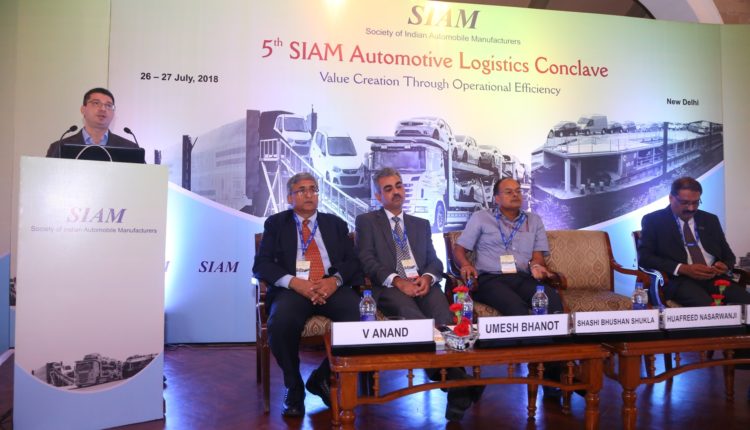
New Delhi, July 27, 2018: Society of Indian Automobile Manufacturers (SIAM), the apex body of the automobile industry held its 5th SIAM Automotive Logistics Conclave, a two day event which concluded today amidst call for synergizing multi-modal logistics and Original Equipment Manufacturers (OEM) besides upgrading to single window logistics to address challenges in India’s fast moving automotive logistics sector.
Mr Shashi Bhushan Shukla, Member (Traffic) at Inland Waterways Authority of India, while speaking at the session titled “Multi-modal- Only way to handle future growth’’ informed that the National Waterways-1 now has four permanent terminals and 19 floating terminals. He elaborated on the extensive development taking place in Inland waterways and how it can be leveraged by the auto industry in vehicle transportation.
“Now the focus has come on inland waterways and coastal shipping. The ongoing projects include three multi modals and two inter modal terminals. Automotive logistics will be in transportation of cars using waterways. Manufacturers in South can access the Nepal markets using the multi modal transportation using National Waterway-1. Haldia will be a big terminal which is coming up at a cost of Rs 500 crore. This will help in transporting and connecting with the north-eastern states,” Mr Shukla explained.
Mr Amit Bhardwaj, Deputy Advisor (Transport) at NITI Aayog said logistics is an important area for the government and will have data analytics centre for logistics besides a single window logistics for e-market place and a National Logistics Action Plan for the next 25 years.
“We have now started benchmarking logistics in global stage. We are closely analysing logistic index of World Bank. We are identifying commodity specific interventions and the kind of synergies we can create with various players. We are soon coming up with National Logistics portal, which will be a single window for the logistics industry. The logistics industry has poor standards and need to work on standardization. The industry has the potential and will provide 20 million jobs by 2022,” Mr Bhardwaj asserted.
Further during the session on “Improving Efficiencies, Mr Waman Parkhi, Partner, KPMG argued that Goods and Service Tax (GST) can actually bring in efficiencies. “Value is not created by chance. It is the result of multiple forces working together GRIP (GST, Regulatory, Infrastructure and Partnership) is creating value for each partner in the value chain, and especially in the logistics industry. We are talking of GST as a game changer, but are we really reaping the benefit out of it ?,” observed Mr Parkhi.
Mr Jasjit Sethi, CEO, TCI Supply Chain Solutions lamented on the need to have efficiency drivers. He stressed for quality infrastructure, standardisation of process and practices with controls based on technology and digitization, the immediate requirements for the logistics industry as it moves on to the next level of growth. “The parameters which the industry has to look at are for transit, safety, cost and asset utilization,” he added.
Mr Raman Kumar Sharma, CEO of Automobile Skill Development Council (ASDC) laid stress on skilling on driver training and the need for proper facilities for drivers to ensure retention and talent. Drivers are key to logistics growth and they must be treated as par with the professionals those passing from premier technological institutions, who get due respect and value.
On day one, delegates spoke on opportunities and bottlenecks plaguing the sector with fluctuating fuel prices, lower skillsets, lack of multi-modal transport and digitization which they termed as impediments to growth of the sector.
Mr Prem K Verma, Chairman, SIAM Logistics Group and Project Leader- Tata Motors spoke on the need for the automotive logistics industry to focus on skill development and ensure efficiency in its system and cost to enhance the supply chain, while Mr Anurag Mehrotra, Managing Director of Ford India urged the government to create better multi-modal infrastructure for OEMs, vehicle manufacturer along with adequate policy supports. He was of the view that logistics have a strategic role to play in India’s economy and must get obsessed with technology and must be operationally fit.
Col Prashant Mishra, Director (Operations) at Land Port Authority of India more warehouses are being set –up to facilitate movement of goods at international borders. The aim, he said to reconnect at borders. Similarly, Dr Monica Agnihotri, Executive Director (Freight Marketing), Ministry of Railways said more freight terminals have been established to handle automobile traffic and many more rakes and terminals are coming up as the Indian Railways anticipates big growth as demand will pick up much faster and will require a lot of infrastructure. On the other hand, Mr B Krishnamoorthy, Executive Director (Indian Ports Association), under the Ministry of Shipping said the industry must look at multi-modal transport system including coastal shipping. Cars can be picked-up from the manufacturing facility in India and shipped from at ease and is cost-effective, he explained.
The event concluded with footfall of over 180 delegates from the government and industry.

